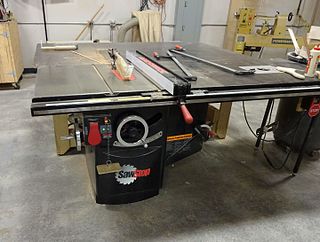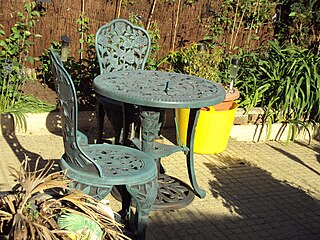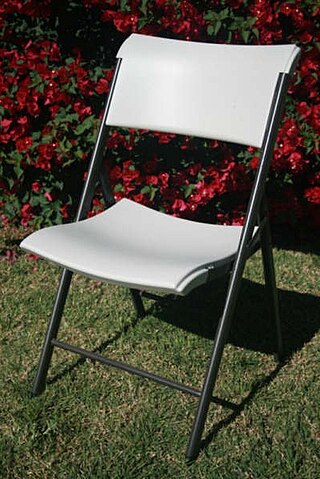
Woodworking is the skill of making items from wood, and includes cabinetry, furniture making, wood carving, joinery, carpentry, and woodturning.

A workbench is a sturdy table at which manual work is done. They range from simple flat surfaces to very complex designs that may be considered tools in themselves. Workbenches vary in size from tiny jewellers benches to the huge benches used by staircase makers. Almost all workbenches are rectangular in shape, often using the surface, corners and edges as flat/square and dimension standards. Design is as varied as the type of work for which the benches are used but most share these attributes:

A chair is a type of seat, typically designed for one person and consisting of one or more legs, a flat or slightly angled seat and a back-rest. They may be made of wood, metal, or synthetic materials, and may be padded or upholstered in various colors and fabrics.

Wood carving is a form of woodworking by means of a cutting tool (knife) in one hand or a chisel by two hands or with one hand on a chisel and one hand on a mallet, resulting in a wooden figure or figurine, or in the sculptural ornamentation of a wooden object. The phrase may also refer to the finished product, from individual sculptures to hand-worked mouldings composing part of a tracery.

A table saw is a woodworking tool, consisting of a circular saw blade, mounted on an arbour, that is driven by an electric motor. The blade protrudes through the top of a table, which provides support for the material, usually wood, being cut.

Park furniture is furniture in a park. It is often made out of iron or wood.

In architecture, a deck is a flat surface capable of supporting weight, similar to a floor, but typically constructed outdoors, often elevated from the ground, and usually connected to a building. The term is a generalization from the deck of a ship. A level architectural deck may be intended for use by people, e.g., what in the UK is usually called a decked patio. "Roof deck" refers to the flat layer of construction materials to which the weather impervious layers are attached to a form a roof. It is known as the "roof deck", and they may be either level or sloped.

A picnic table is a table with benches, designed for working with and for outdoor dining. The term is often specifically associated with rectangular tables having an A-frame structure. Such tables may be referred to as "picnic tables" even when used exclusively indoors.

Garden furniture, also called patio furniture or outdoor furniture, is a type of furniture specifically designed for outdoor use. It is typically made of weather-resistant materials such as aluminium which is rust-proof.

A folding chair is a type of folding furniture, a light, portable chair that folds flat or to a smaller size, and can be stored in a stack, in a row, or on a cart.

A bench is a long seat on which multiple people may sit at the same time. Benches are typically made of wood, but may also be made of metal, stone, or synthetic materials. Many benches have back rests, while others do not and can be accessed from either side. Arm rests are another common feature. In many American public areas, benches may be donated by persons or associations, as indicated by an affixed plaque, a common form of memorial to a deceased person. Benches may be placed outdoors or indoors, but are more often found outdoors.

Plastic lumber is a plastic form of lumber made of virgin or recycled plastic. It is mostly made of plastic and binders such as fiberglass or rebar; not to be confused with wood-plastic composite lumber. Widely employed in outdoor decking, it is also used for molding and trim and garden furniture such as park benches. Resistant to cracking and splitting when appropriately installed, plastic lumber can be molded with or without simulated wood grain details. Even with a wood grain design, plastic lumber is still easy to distinguish visually from natural timber: the grains are the same uniform color as the rest of the material.
This glossary of woodworking lists a number of specialized terms and concepts used in woodworking, carpentry, and related disciplines.

A music stand is a pedestal or elevated rack designed to hold sheets of music in position for reading. Most music stands for orchestral, chamber music or solo orchestra-family instruments can be raised or lowered to accommodate seated or standing performers, or performers of different heights. Many types of keyboard instruments have a built-in or removable music rack or stand where sheet music can be placed. Music stands enable musicians to read sheet music or scores while playing an instrument or conducting, as the stand leaves the hands free. For choirs, singers typically hold their music in a folder, and singers performing solo recitals or opera performances typically memorize the lyrics and melodies. Some singers use stands, such as lounge singers and wedding vocalists who have a repertoire of hundreds of songs, which makes remembering all of the verses difficult.
Teak wood is used for making boats, furniture, and other things which require resistance to the elements. Teak is used for outdoor furniture but is not recommended for full exposure to sunlight. Being more expensive than most other woods, teak furniture has become something of a status symbol. Not only is it common for a teak bench, chair, or table to last 70 years with the correct care plan, it is also common to pass down such furniture to future generations as an heirloom.

A potting bench or gardening table is a kind of workbench used for small gardening tasks such as transplanting seedlings. A basic potting bench has a work surface at bench height, comfortable for a standing person; and storage for potting soil, pots, and tools. The same furniture is often also used to display potted plants, even indoors.

A folding table is a type of folding furniture, a table with legs that fold up against the table top. This is intended to make storage more convenient and to make the table more portable. Many folding tables are made of lightweight materials to further increase portability.

Metal furniture is furniture made with metal parts: iron, carbon steel, aluminium, brass and stainless steel.

The conservation and restoration of clocks refers to the care given to the physical and functional aspects of time measuring devices featuring "moving hands on a dial face" exclusive of watches. Care for clocks constitutes regulating the external environment, cleaning, winding, lubrication, pest-management, and repairing or replacing mechanical and aesthetic components to preserve or achieve the desired state as specified by the owner. Clocks are typically composed of multiple types of materials such as wood, metal, paint, plastic, etc., which have unique behaviors and environmental interactions, making treatment options complex. The materials used and the complexity of clockwork warrant having a Horological Conservator complete the work.
The conservation and restoration of outdoor murals is the process of caring for and maintaining murals, and includes documentation, examination, research, and treatment to insure their long-term viability, when desired.



















